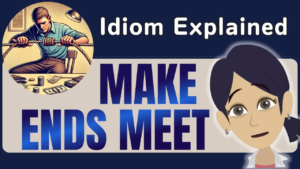Have you ever sat in a meeting or casual discussion and heard someone say, “The bottom line is…” only to wonder what line they were talking about? Misunderstanding an idiom in English can be awkward, especially when it’s used in high-stakes conversations. In professional contexts, phrases like “the bottom line” can reveal the most crucial insight, so missing its meaning might lead to confusion—or even costly mistakes. In this post, you’ll learn exactly what this idiom means, how it originated, and why it’s so important for enhancing your English communication. You’ll also discover relatable examples and a few amusing anecdotes along the way.
Introduction to “The Bottom Line”
A Practical Understanding
When someone mentions “the bottom line,” they’re pointing to the most essential fact or outcome in a given situation. It’s not just financial jargon; it can be applied to everyday topics such as completing a personal project, planning a vacation, or organizing household tasks. You might hear, “The bottom line is we need to finish this on time,” or “The bottom line is to keep everyone safe.” In other words, this idiom highlights the key point that cannot be overlooked.
Why It Matters
- Clarity in Communication: Using “the bottom line” helps you clarify priorities and prevent misinterpretation.
- Efficiency: It enables everyone involved to focus on what truly matters, whether in business, academics, or personal life.
- Cultural Fluency: Grasping this idiom broadens your understanding of English expressions, fostering smoother interactions with native speakers.
Decoding “The Bottom Line”: Origin and Definitions
Accounting Roots
The phrase “the bottom line” emerged from accounting, where the final line of a financial statement indicates net income or net loss. Because that line sums up a company’s overall performance, the expression evolved into a metaphor for any vital conclusion or ultimate takeaway.
Note: Some believe the term gained popularity in the 1960s or thereabouts, reflecting its modern origins compared to idioms dating back centuries. While exact dates may vary depending on sources, the concept consistently relates to the final summary in financial documents.
Core Meaning
- Essential Focus: It’s the primary or most significant piece of information in a discussion.
- Final Result: Whether you’re talking about a game score, a business profit margin, or a project’s success criteria, the “bottom line” points to the end result that really matters.
By tying it back to its financial birth, you’ll see why English speakers equate “the bottom line” with “the most important thing.” When you hear the phrase in everyday conversation, think of it as the logical conclusion or crucial point everyone must keep in mind.
Anecdote: Misunderstanding “The Bottom Line”
A Lighthearted Moment
Picture this scenario: a coworker new to English idioms was in a team meeting. The manager said, “The bottom line is we need to reduce expenses.” Unaware of the idiom’s meaning, the coworker glanced at the literal bottom line of a printed cost sheet, adjusting margins and adding comments there. This misunderstanding amused the entire team, but it was also a gentle reminder of how easily we can get confused by figurative language.
Lesson Learned: Don’t feel embarrassed by small mistakes. Instead, see them as opportunities to grasp idiomatic expressions more deeply. The coworker soon realized that “the bottom line” has little to do with an actual line on a page—and everything to do with focusing on crucial objectives.
Examples of “The Bottom Line” in Action
- Business Meeting
- Sentence: “The bottom line is we must increase revenue next quarter.”
- Explanation: The company’s highest priority is generating more income.
- Financial Report
- Sentence: “Our bottom line shows a modest profit this month.”
- Explanation: The profit figure is the key indicator of the company’s financial health.
- Project Management
- Sentence: “The bottom line is to meet the launch deadline.”
- Explanation: While details matter, delivering on time is the non-negotiable outcome.
- Everyday Decision-Making
- Sentence: “The bottom line is that we need a new car soon.”
- Explanation: The final conclusion is clear—purchasing a car has become urgent.
- Team Communication
- Sentence: “We’ve discussed multiple strategies, but the bottom line is to choose one that aligns with our budget.”
- Explanation: After exploring various ideas, the key factor is financial feasibility.
A Success Story That Highlights “The Bottom Line”
From Confusion to Triumph
Imagine a diligent employee named James who was assigned a high-priority project. His manager repeatedly stressed, “The bottom line is to finish on time and remain under budget.” At first, James focused too heavily on trimming minor costs, ignoring the bigger picture. Fortunately, he realized the true meaning of the phrase: the project’s success hinged on meeting both the deadline and financial constraints.
James delegated tasks efficiently, asked for help when needed, and prioritized resources to stay on track. In the end, the project was delivered earlier than expected. Profits exceeded forecasts, and the team celebrated a significant milestone.
Key Takeaways:
- Focus on What Matters: Timeliness and budget were the absolute priorities.
- Teamwork: Collaboration ensured complex tasks were tackled by the right people.
- Idiomatic Understanding: Knowing what “the bottom line” really meant saved James from focusing on unimportant details.
10 Fascinating Facts About “The Bottom Line”
- Relatively Modern: It’s believed to have gained momentum in the second half of the 20th century.
- Financial Heritage: Originates from the final line on an income statement, usually showing net profit or loss.
- Cross-Industry Use: It’s popular in business, but also in fields like sports and media.
- Synonymous with Net Income: When talking about finances, “the bottom line” often means earnings after all costs.
- Works in Sports: Some sports analysts use it to sum up a game’s final score or turning point.
- Emphasizes Conclusions: Whether positive or negative, it underscores the result that must be acknowledged.
- Used in News Headlines: Journalists favor the phrase to highlight a story’s principal conclusion.
- Widespread in Corporate Culture: Many board meetings end with the phrase, crystallizing action points.
- Can Spark Humor: Misinterpretations can be amusing, like rearranging an office thinking “the bottom line” referred to physical space.
- Encourages Directness: The phrase helps people steer conversations toward essential outcomes.
Practice with Example Sentences
- “The bottom line is we need to keep customers happy to stay competitive.”
- Application: Focus on service quality and user satisfaction.
- Possible Misunderstanding: Believing you need to draw a line at the bottom of a survey report rather than improving customer service.
- “Our bottom line won’t improve unless we cut unnecessary spending.”
- Application: Identify and eliminate wasteful practices.
- Possible Misunderstanding: Thinking “cut” means physically cutting documents instead of reducing overhead costs.
- “The bottom line is to finalize this deal before the end of the quarter.”
- Application: Prioritize tasks that expedite contract negotiations.
- Possible Misunderstanding: Focusing on the literal bottom line of the contract rather than the agreement itself.
- “The bottom line is that clarity in communication can prevent major issues.”
- Application: Make instructions explicit and confirm everyone’s understanding.
- Possible Misunderstanding: Paying more attention to document formatting than actual content.
- “For this project, the bottom line is to maintain safety standards.”
- Application: Comply with regulations and ensure team well-being.
- Possible Misunderstanding: Confusing “bottom line” with minor details on a checklist.
Real-Life Business Scenario
A Remarkable Turnaround
In a struggling company, the CEO realized the true meaning of “the bottom line” was not about constant cost-cutting. Rather, improving product quality and building trust with clients would create long-term profitability. As a result, the company shifted from slashing resources to investing in better design, additional staff training, and reliable customer support. This strategic approach successfully boosted both sales and public perception.
Humorous Twist: If the CEO had misunderstood the idiom, perhaps fixating on the actual bottom line of a financial report, the company might have wasted time reformatting documents instead of rethinking policies. This highlight underscores how understanding an idiom can prevent embarrassing missteps.
Related Expressions to Broaden Your Idiom Knowledge
Similar Expressions
- “The crux of the matter”: Pinpoints the core issue in a situation.
- “The heart of the matter”: Stresses the central, most pressing concern.
- “The nitty-gritty”: Focuses on the essential practical details.
Opposite Expressions
- “The icing on the cake”: Implies an additional perk to something already positive.
- “The cherry on top”: Conveys an extra bonus that enhances an already good outcome.
Other Useful Idioms
- “In a nutshell”: Means to summarize succinctly.
- “Cut to the chase”: Suggests skipping irrelevant details and highlighting the main point.
- “Get to the point”: A direct way to say “please focus on the essential information.”
In a Nutshell: A Short Illustrative Story
Sarah wanted a quick summary of her friend’s weekend hiking trip. Her friend said, “In a nutshell, it was challenging but worth it for the scenery.” By using this concise idiom, the friend avoided a lengthy monologue.
Why It Relates to “The Bottom Line”: Both phrases guide you toward what’s most important. “In a nutshell” is about brevity, while “the bottom line” emphasizes finality and significance.
Quick Quiz on “The Bottom Line”
Question: What does “the bottom line” signify in everyday English?
- A literal horizontal line drawn at the end of a document.
- The most crucial point or result.
- The opening statement of an argument.
Answer: Option 2. It always points to what is most vital or definitive in any situation.
Conclusion: Embrace “The Bottom Line” for Stronger Communication
- Understand the Core: Recognizing that “the bottom line” signals the central or final aspect of a discussion will keep you from missing crucial points.
- Avoid Misinterpretations: Whether at work or in casual settings, clarity about idioms prevents confusion and lightens the mood when discussions become complicated.
- Grow Your Skills: Learning idioms like this elevates your ability to hold meaningful conversations in English, ensuring you stand out in both professional and personal interactions.
- Keep Practicing: Review authentic texts, watch English-language media, and don’t hesitate to experiment with new expressions in your daily life. Consistent application leads to lasting fluency.
By mastering “the bottom line,” you’ll not only grasp critical information more confidently but also communicate in a way that resonates with clarity and purpose.









Comment